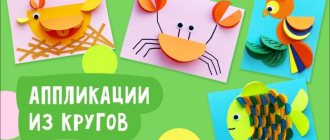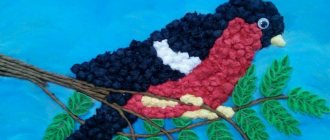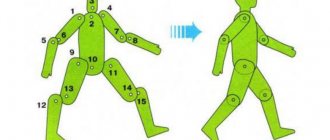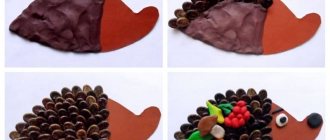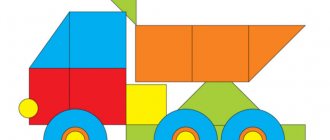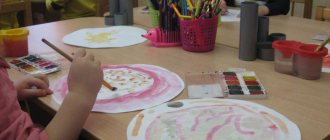Yulia Karateeva
Summary of the educational situation on the application on the topic “Tools”
Collaborative educational situation
teacher with preparatory group children
Topic: " Tools
»
Goal: Create conditions for consolidating and generalizing knowledge about working tools and their purpose
.
Tasks :
Educational
: clarify, expand and activate children’s vocabulary on the topic “Tools and
tools
;
consolidate the ability to cut a strip folded in half (several times)
to obtain a symmetrical shape, figures of the same size; consolidate the ability to cut a circle from a square, an oval from a rectangle
Educational: develop children's creative imagination
, attention, observation, ability to make logical conclusions; develop the ability to coordinate your actions with the work of the entire team
Educational: cultivate a sense of goodwill, responsibility and cooperation; to form a positive attitude of children towards the teacher and towards each other.
Methods and techniques:
Visual (show, demonstration)
;
Verbal (literary word, conversation, question-answer)
;
Gaming (didactic game)
Practical (completing the task)
Pedagogical technologies: socio-game technologies
Materials: Whatman paper, colored paper of different formats and colors, scissors, glue, napkins for work. Toy instruments
: hacksaw, hammer, rake, screwdriver, pliers, thimble,
tool
, letter.
Preliminary work: Reading works: S. Marshak “Master - Lomaster”
,
“How a plane made a plane”
;
examination of tools
;
writing a descriptive story; construction with construction kit parts (with screwdriver, wrench)
Studying anatomy
Older children will be interested in studying human anatomy using the applique as an example. This game will not only develop fine motor skills and perseverance, but will also introduce children to the structure of internal organs.
Depending on age and level of training, the number of organs may vary. To play you will need:
- template (contours of the human body);
- organs (brain, stomach, lungs, liver, heart, intestines and others);
- diagram with the location of organs on the template and their names;
- glue.
The essence of the game is to introduce the child to internal organs.
- Each organ is taken in turn. Its name is clearly pronounced and shown on the diagram where it should be located. For older children, the purpose of this organ is explained.
- The child takes the organ shown and glues it onto the person’s stencil for appliqué.
- The actions are repeated with each organ.
If this is not the first time an acquaintance with the internal structure of a person occurs, then the child can be asked to independently glue the organs onto the template.
Man in motion
The appliqué of a person in motion helps develop a child’s creative abilities and imaginative perception. The difficulty of this task is that rectangles and squares of different sizes are used for the work.
For the application you will need:
- blanks of squares and rectangles made of paper;
- cardboard;
- glue.
The work consists of several stages:
- The child is asked to choose cardboard - the base on which he will stick the figure.
- The adult pronounces the pose that will be depicted in the form of an appliqué. He explains how the arms and legs are positioned in this pose, and what features there are. For example: a person runs, bends over, jumps.
- The child takes the prepared templates and lays them out in the desired position on the cardboard. If you have completed the figure correctly, then glue the rectangles with glue.
- If mistakes are made in a pose, the adult tells you how to correct it.
The application of a person in motion will be useful for children of primary school age and art students.
What activities should you do with your child to teach him appliqué?
First give him a strip of paper and help him make the grass, that is, the cuts. From another strip you can make bricks or cubes. To do this you need to cut the strip completely.
Teach your preschooler to use glue, both liquid and solid. Show that glue can be applied to paper in different ways. You can glue the paper completely and along the edges and with dots.
Then you can move on to more complex figures. Teach him to cut out the shapes that make up most objects. For example, a triangle can be obtained by cutting a square diagonally (you get a sail). A trapezoid will turn out if you cut off the corners of a rectangle (you will get the roof of the house). A circle can be obtained if the corners of a square are gradually cut off by rounding (this is how you can get the sun or an apple). That is, strive to turn all activities into an entertaining game.
When folding paper, children do not pay attention to the position of the corners of the sheet of paper. You need to show the children that it will be correct to fold the corners and then use your fingers or palms to follow the fold line. Pay attention to this point.
The application has several stages of work, each of which is performed in turn. Before cutting, it is very important to see in your mind what the end result will be. Only after this you need to start cutting. You may even have to sketch out the outline of the image first. And you need to cut it out of a piece of paper that fits either in size or shape to the image that you have in mind. And already working with scissors, children should imagine what should happen. To develop such abilities in children, offer them tasks with obvious solutions. For example, if you give a child one small square of paper and one rectangle and ask him to cut out a pear and a berry, then he should imagine the result himself and realize that it is easier to cut a pear from a rectangle, and a berry from a small square.
Movable little man
Patterns of human body parts can make applique more interesting for children. With their help, it is possible to achieve a realistic, bright picture or give it dynamics. Surely older children will enjoy the dynamic applique.
To work you will need:
- templates of body parts (arms, legs, torso, head);
- screws and nuts from a metal constructor;
- cardboard;
- glue;
- scissors.
The work is carried out in several stages:
- Templates printed on paper are cut out and glued onto thick cardboard. This makes them stronger. Then the parts are cut out of cardboard.
- Place your hands on the body and use sharp scissors to make a through hole. A screw is inserted into it and a nut is tightened. I repeat the operation with my legs.
- The head is attached to the body in a similar way.
The little man gains mobility and is ready to play. To complicate the work, you can create additional connections at the elbows and knees.
Applications are a fascinating creativity that develops imaginative thinking, perseverance, and fine motor skills. Working with paper is suitable for children of all ages. Having mastered the skills of appliqué on paper, you can move on to more interesting and complex activities - for example, creating a reusable game with felt Velcro.
